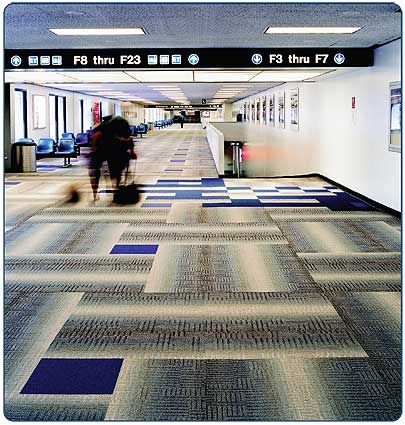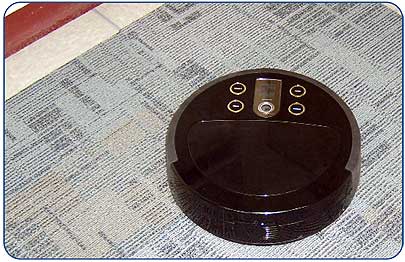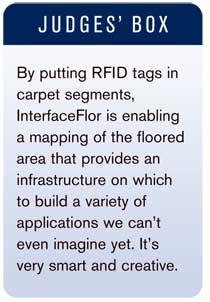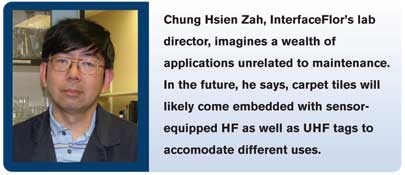Award Winner: Most Innovative Use of RFID
June 1, 2008—In the $14 billion carpet and rug industry, carpet tiles are the star of the show. For the past three years, carpet tiles have been growing faster than any other type of flooring. Last year, InterfaceFlor, the world’s leading manufacturer of carpet tiles, said its fourth quarter was the best in the company’s history, and president and CEO Dan Hendrix credits the demand for modular carpet, both domestically and internationally, for helping to drive an 18.2 percent increase—to $1.1 billion in sales—in annual growth
To help keep its edge, LaGrange, Ga.-based InterfaceFlor developed IntelligentFlor, an RFID system designed to bring efficiencies and cost savings to commercial carpet maintenance. Carpet cleaning, it turns out, is a huge issue—for the customer and for InterfaceFlor, says Chung Hsien Zah, director of Interface’s analytical labs. Sometimes customers return carpet tiles, complaining about defects in the material. When Interface analyzes the carpet tiles, it often finds that poor maintenance, which results in soil buildup from foot traffic, is the reason they’ve lost luster and color.
IntelligentFlor, still in the prototype stage, can detect which carpet tiles were vacuumed and which weren’t. An RFID passive tag is embedded in the corner of each carpet tile. When a vacuum equipped with an RFID interrogator passes over a tag, it sends information on the tag’s location—as well as the time—via a Bluetooth connection to a computer software program that maps the tag’s location on a grid. Armed with a visual display, building property managers can take steps to keep their carpets cleaner, such as pinpointing for the evening’s cleaners the areas of the carpet that weren’t vacuumed the previous night. And that, Interface believes, will make managers less likely to consider wood or vinyl flooring, which they might otherwise perceive as being easier and less costly to maintain.
Interface’s choice of RFID technology to solve the maintenance problem bucks some industry trends. Zah says carpet industry trade associations, such as the Carpet and Rug Institute (CRI), have certified cleaning chemicals, machines and maintenance contractors to assure commercial customers that they’re getting the highest-quality service. But Zah believes this approach may send the wrong message to customers, which could view the need for such certifications as evidence that carpets actually are harder to maintain than other kinds of flooring.
More important, Zah says, it doesn’t get to the heart of the problem. When Interface discussed the issue with various maintenance industry associations, the company learned that all cleaning companies operate under the same economic model in order to make a profit on their maintenance contracts: Basically, cleaners must work quickly, vacuuming 1,000 square feet in six to eight minutes, so they typically turn their attention to areas that look dirty. But that means they miss a lot of places, allowing dirt to build up and damage the carpet surface.
Interface believes its RFID system will enable cleaners to do a better job in the same amount of time. Otherwise, building managers dissatisfied with how their carpets look will continue to try different cleaning companies until they give up and opt for another type of flooring. “That’s hurting our market,” Zah says. “That’s the reason we say you have to identify the real problem and solve it.”
Clean-Cut Research
IntelligentFlor was developed as part of Interface’s Smart Tile project, a research-and-development effort to use technology to benefit customers and retain a leadership position in the market. Interface experimented with wired sensors to record carpet-cleaning activity and send that information to a mapping application, but found it was too difficult to make the necessary electrical connections among carpet tiles in buildings that didn’t have raised floors. RFID has the advantage of being a wireless technology, and by 2006, Interface believed the performance and price of the technology had reached levels that made it practical for wide-scale deployment.
In addition, RFID vendors had developed tags that were small enough to embed in carpet tiles. Interface is using 50-by-50-mm tags that are roughly 600 microns thick. The company has tested its prototype system with high-frequency and ultrahigh-frequency passive tags from several RFID vendors, including Alien, Avery Dennison, Omron, Texas Instruments and UPM Raflatac; it has not yet settled on one tag supplier. Interface also has tested HF interrogators from APSX and SkyeTek, and a UHF interrogator from SkyeTek.

While both HF and UHF tags can be read successfully through the carpet tiles, Zah believes the HF tags and interrogators will be the preferred choice of the maintenance equipment vendors that will have to bear the expense of installing readers on the vacuums they sell or lease to building maintenance and cleaning contractors. “A reader of an HF tag is probably $20 to $40, while a UHF reader is $1,000,” Zah says. “If they’re paying just $100 for a [cleaning] machine, they won’t like to install a $1,000 reader on that.”
Zah’s team tested the RFID system with an iRobot Create vacuum-cleaning machine equipped with an RFID interrogator, running the device over the RFID-tagged carpet tiles in its lab. They found that embedding the tag in the corner of each carpet tile provided the best read rate. The biggest challenge the team confronted was finding a tag that was durable enough to survive standard carpet wear-and-tear testing.
While Interface will be responsible for embedding the RFID tags in its carpet tiles, the company is leaving the development of RFID-equipped vacuums and software applications to others. But Zah thinks it would be a good idea to mount an LCD on top of a vacuum, giving a worker a real-time map of the floor highlighting areas that weren’t cleaned.
Tennant, a Minneapolis-based manufacturer of cleaning solutions and maintenance equipment, is currently working with hardware and software developers to create an RFID interrogator to mount on its vacuums, as well as a maintenance application to handle the data generated by the tags. Zah says he expects a pilot trial to launch midyear and an announcement of the entire solution by the end of the year.
Tennant declines to provide details about the upcoming solution, but says the Interface system fits into its goals to provide customers, most of which are contract cleaners, with tools to maintain consistent floor cleaning by addressing cleaning issues before there’s a problem. “The business of providing a clean facility is extremely competitive,” says Bob Erko, chief engineer in Tennant’s advanced product development group. Typically, cleaning contracts have a 30-day clause that allows property managers to cancel them if quality is not maintained, so some of Tennant’s customers have asked if the company could help them quantify the frequency and location of cleaning.
“Optimizing the application of labor and equipment can have a large impact on our customers’ profitability,” Erko says. “The solution will enable customers to uniformly apply and monitor processes across multiple facilities.”
A Clean Future
While first-generation maintenance applications of this technology will likely be aimed at helping human workers clean more efficiently, Zah believes the next stage of development will bring robotics into the picture. “Today, 70 percent of maintenance costs are labor,” he says, “so the only way to reduce building costs is to reduce labor maintenance costs.” As technology advances lead to the creation of more efficient cleaning robots for the commercial sector, these systems could take over the job. They could be built to read maps generated in real time to identify locations that require cleaning. Interface is working with Microrobot, a Korean company that develops and manufactures educational and personal robots, on robot navigation research.
Interface also aims to work with partners that would develop applications that could leverage sensor-equipped RFID tags to, for example, detect and record foot traffic throughout a building. That could help determine whether the robot (or, initially, a human) cleans an area at all that day, or whether it cleans a particular area—a lobby, for example—multiple times. That could help companies save money on cleaning chemicals and adhere to “green” building standards, which often try to limit the use of chemical cleaners.
Imagining a wealth of applications unrelated to maintenance, Zah says that in the future carpet tiles will likely come embedded with sensor-equipped HF as well as UHF tags to accommodate different uses. For example, a PDA could be equipped with an RFID reader and an application that works with an indoor positioning system to map a person’s location within a building in real time. It could provide directions to an office or, in the event of a fire, to an emergency exit.
Other applications could be developed to track assets, such as EKG machines in hospitals or laptops in office buildings. Current systems use mobile tags and fixed readers, with the tagged devices read when they pass through an RFID portal. Instead, Interface’s system would use fixed tags and mobile readers, Zah says; the readers embedded in the devices could use the tags in the carpet to pinpoint location at any time.

Interface—which is in the process of patenting its method for embedding RFID tags into its carpet tiles, as well as in vinyl, wood, cork and leather tiles—is trying to identify companies that would be interested in using its technology to develop such applications. The company believes the time is right for this, because a wireless RFID-based system in carpet tiles doesn’t add complexity or cost to the installation process.
For now, Interface says its main focus is on maintenance. Zah sees a bright future for RFID in the carpet industry, expecting it to become a 1-billion-tag market. Interface itself manufactures 110 million carpet tiles annually, which accounts for about one-third of the market in the carpet tile business and roughly 10 percent of the total floor business.
But success has its price. While IntelligentFlor may deter some property managers from switching to other types of flooring, Interface could lose some replacement carpet sales. Still, that pales in comparison to better serving the customer, Zah says. “It may be something of a disadvantage for us,” he says, “but we identified this as a customer need.”



